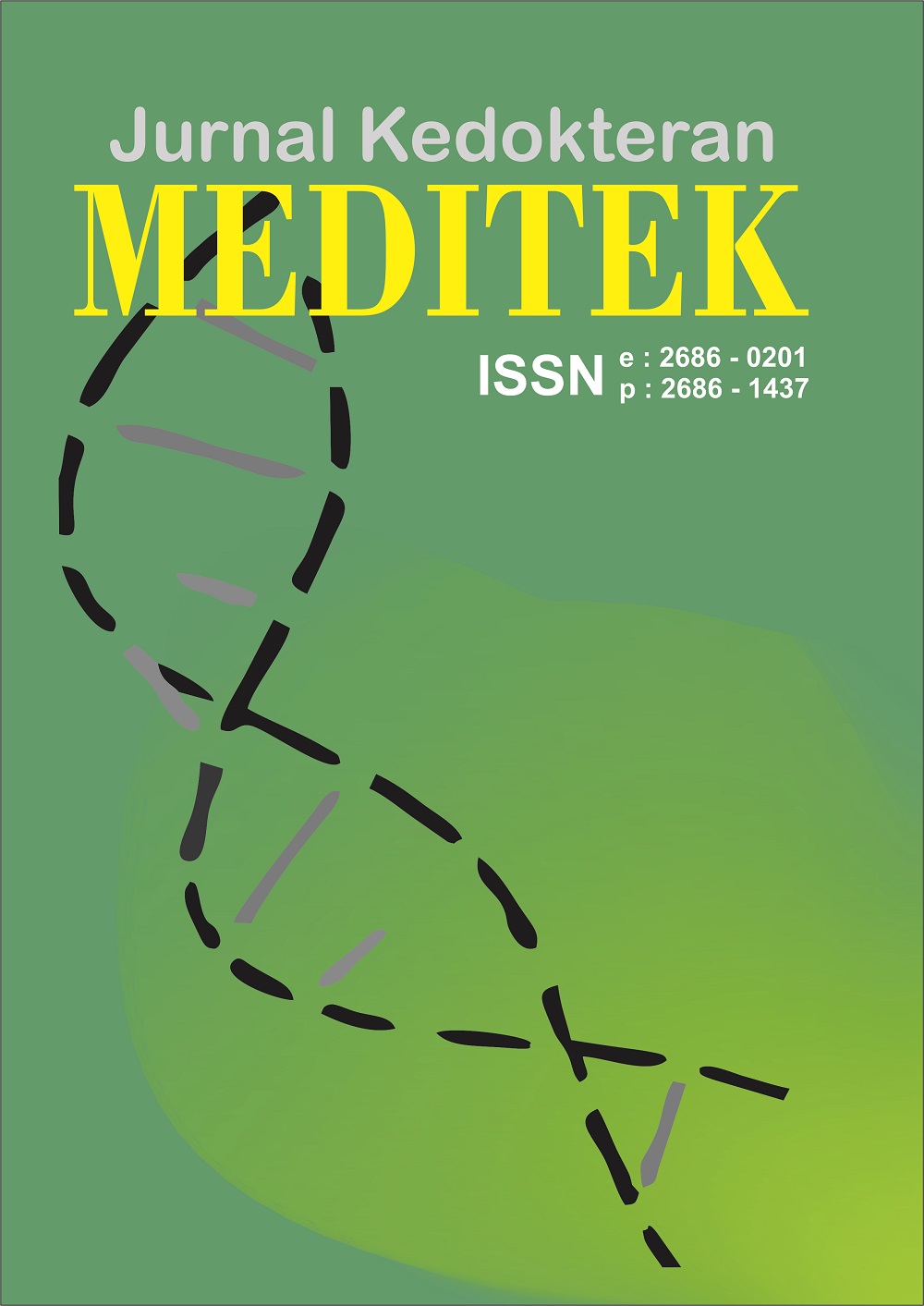Efektivitas Daya Hambat Disinfektan Klorin terhadap Bakteri Escherichia Coli Penghasil Extended Spectrum Beta Lactamase
DOI:
https://doi.org/10.36452/jkdoktmeditek.v27i3.2002Keywords:
Escherichia coli, ESBL, klorin, waktu kontakAbstract
Kerja shift adalah pembagian jam kerja dalam waktu 24 jam yang dilakukan secara bergantian biasanya terbagi atas shift pagi, shift sore, dan shift malam. Kerja shift dapat memberikan dampak positif maupun negatif bagi pekerja antara lain dalam aspek fisiologis, psikososial, kinerja, maupun kesehatan dan keselamatan kerja. Tujuan penelitian adalah untuk mengetahui hubungan kualitas tidur dengan fungsi eksekutif pada pekerja shift dan non shift. Penelitian bersifat analitik observasional dengan pendekatan desain cross sectional. Penelitian dilakukan pada bulan Agustus-September 2020. Total sampel sebanyak 44 orang yang dipilih dengan teknik consecutive sampling berdasarkan kriteria inklusi dan eksklusi. Data dikumpulkan melalui pengisian kuesioner yaitu Pittsburgh Sleep Quality Index (PSQI) untuk mengukur kualitas tidur, sedangkan untuk menilai fungsi eksekutif menggunakan Trail Making Test A (TMT-A) dan Trail Making Test B (TMT-B). Hasil penelitian menunjukkan bahwa tidak terdapat hubungan antara kualitas tidur dan fungsi eksekutif pada pekerja shift dan non shift (P<0,05). Faktor usia dan pendidikan dapat menjadi penyebab tidak terdapatnya hubungan antara kualitas tidur dengan fungsi eksekutif.
References
Bajaj P, Singh NS, Virdi JS. Escherichia coli β-lactamases: What really matters. Front Microbiol. 2016;7(MAR):1–14.
Blount ZD. The unexhausted potential of E. coli. Elife. 2015;4:e05826.
Itis.gov. (2020). ITIS Standard Report Page: Escherichia coli. [online] Available at: https://www.itis.gov/servlet/SingleRpt/SingleRpt?search_topic=TSN&search_value=285&print_version=PRT&source=to_print#null [Accessed 24 Jan. 2020].
Parija SC. Textbook of microbiology & immunology. 2nd ed. India: Elsevier: 2012.
Carroll KC, Morse SA, Mietzner T. Miller S, Mikrobiologi kedokteran jawetz, melnick & adelberg. Edisi ke-27. Jakarta: EGC: 2018.
Murray PR, Rosenthal KS, Pfaller MA. Medical microbiology. 8th ed. Philadelphia: Elsevier; 2016.
McDonnell G, Russell AD. Antiseptics and disinfectants: activity, action, and resistance [published correction appears in Clin Microbiol Rev 2001 Jan;14(1):227]. Clin Microbiol Rev. 1999;12(1):147–79.
Rutala WA, Weber DJ. Uses of inorganic hypochlorite (bleach) in health-care facilities. Clin Microbiol Rev. 1997;10(4):597–610.
Peck B, Workeneh B, Kadikoy H, Patel SJ, Abdellatif A. Spectrum of sodium hypochlorite toxicity in man-also a concern for nephrologists. NDT Plus. 2011;4(4):231–5.
Ghafourian S, Sadeghifard N, Soheili S, Sekawi Z. Extended spectrum beta-lactamases: Definition, classification and epidemiology. Curr Issues Mol Biol. 2014;17(1):11–22.
Tille PM. Bailey and scott's diagnostic micrbiology. 14th edition. St. Louis Missouri: Elsevier; 2017.
Anggraini D, Sholihin UH, Savira M, Djojosugito FA, Irawan D, Rustam RP. Prevalensi dan pola sensitivitas enterobacteriaceae penghasil ESBL di RSUD Arifin Achmad Pekanbaru. J Kedokt Brawijaya. 2018;30(1):47.
LeChevallier MW, Cawthon CD, Lee RG. Factors promoting survival of bacteria in chlorinated water supplies. Appl Environ Microbiol. 1988;54(3):649–54.
Chen YQ, Chen C, Zhang XJ, Zheng Q, Liu YY. Inactivation of resistant mycobacteria mucogenicum in water: Chlorine resistance and mechanism analysis. Biomed Environ Sci [Internet]. 2012;25(2):230–7.
Verspecht T, Rodriguez HE, Khodaparast L, Khodaparast L, Boon N, Bernaerts K, et al. Development of antiseptic adaptation and cross-adapatation in selected oral pathogens in vitro. Sci Rep [Internet]. 2019;9(1):1–13.
Reybrouck G. The testing of disinfectants. Int Biodeterior Biodegrad. 1998;41(3–4):269–72.
Kampf G, Meyer B, Goroncy-Bermes P. Comparison of two test methods for the determination of sufficient antimicrobial activity of three commonly used alcohol-based hand rubs for hygienic hand disinfection. J Hosp Infect. 2003;55(3):220–5.
Norhan SS, Aymen SY, Aly F, Magdy AA. Quantitative suspension tests for the evaluation of bactericidal, fungicidal and sporicidal effects of biocides used in vaccine production facility. African J Microbiol Res. 2014;8(5):417–24
Lima FR, Ahmed S. Activity of disinfectants related to food hygiene and sanitation. North Int Med Coll J. 2015;6(2):64–7.
Perez J, Springthorpe VS, Sattar SA. Activity of selected oxidizing microbicides against the spores of Clostridium difficile: Relevance to environmental control. Am J Infect Control. 2005;33(6):320–5.
Omidbakhsh N. Evaluation of sporicidal activities of selected environmental surface disinfectants: Carrier tests with the spores of Clostridium difficile and its surrogates. Am J Infect Control [Internet]. 2010;38(9):718–22.
Shaikh S, Fatima J, Shakil S, Rizvi SMD, Kamal MA. Antibiotic resistance and extended spectrum beta-lactamases: Types, epidemiology and treatment. Saudi J Biol Sci [Internet]. 2015;22(1):90–101.
Cdc.gov. 2019. Rationale and considerations for chlorine use in infection control for non- U.S. general healthcare settings | Non-U.S. general healthcare settings | clinicians | ebola (ebola virus disease) | CDC. [online] Available at: <https://www.cdc.gov/vhf/ebola/clinicians/non-us-healthcare-settings/chlorine-use.html> [Accessed 16 September 2020].
Alonso-Calleja C, Guerrero-Ramos E, Alonso-Hernando A, Capita R. Adaptation and cross-adaptation of Escherichia coli ATCC 12806 to several food-grade biocides. Food Control [Internet]. 2015;56:86–94.
Thenmozhi S, Moorthy K, Sureshkumar BT, Suresh M. Antibiotic Resistance Mechanism of ESBL Producing Enterobacteriaceae in Clinical Field: A Review. Int J Pure Appl Biosci. 2014;2(3):207–26.
Yedekci S, Erac B, Hoşgör Limoncu M. Detection of the efflux pump-mediated quinolone resistance in ESBL positive Escherichia coli and Klebsiella pneumoniae isolates by Phe-Arg-Beta-naphthylamide. Turkish J Pharm Sci. 2012;9(1):67–74.
World Health Organization (WHO). Cleaning and disinfection of environmental surfaces in the context of COVID-19: Interim guidance. New York City America: Who. 2020;(May):7.
Downloads
Published
How to Cite
Issue
Section
License
Copyright (c) 2021 Krisna Fernanda Suryaputra, Donna Mesina Rosadini Pasaribu, Ade Dharmawan

This work is licensed under a Creative Commons Attribution-NonCommercial-ShareAlike 4.0 International License.


















